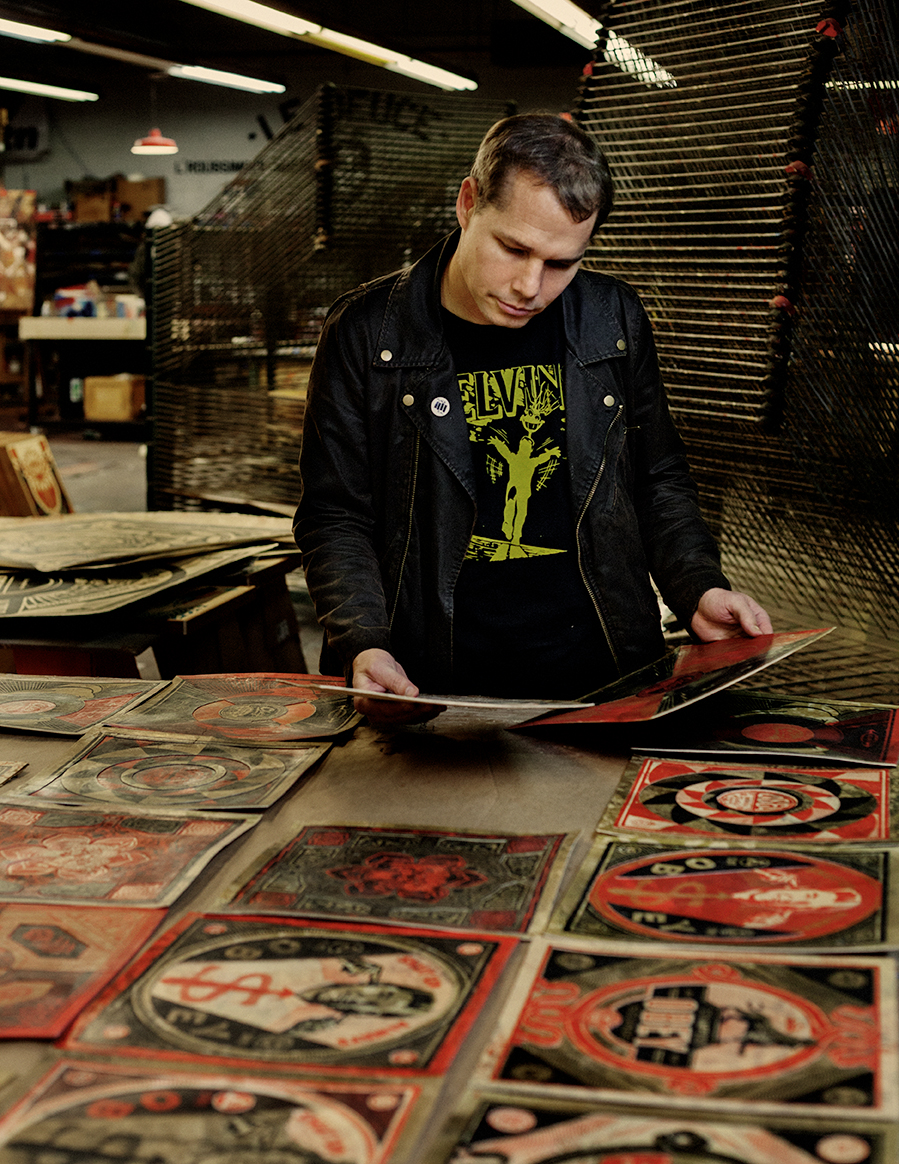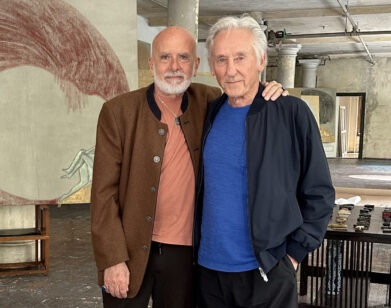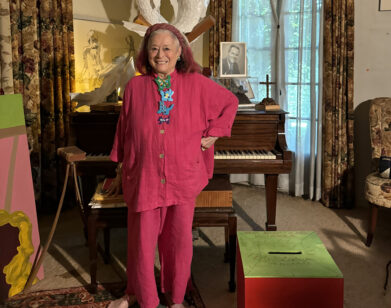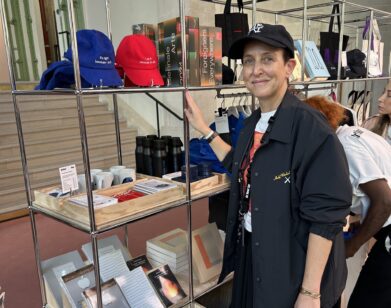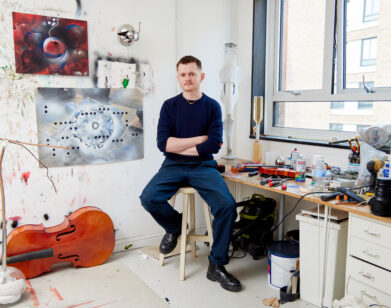Shepard Fairey Paints It Black
ABOVE: SHEPARD FAIREY. PHOTOS BY BRIAN HIGBEE
Art-world elitists, critics, and PhDs seem to enjoy reducing Shepard Fairey to something less than an “artist,” while street art purists with suspect punk rock sensibilities debate the extent to which he’s sold out. So it goes for creatives who have reached Fairey’s level of notoriety and commercial success. Like much of his work, Fairey exists in the public sphere, exposed to the elements, readily available to be built up and torn down on a whim. He is quick—almost conditioned, it seems—to defend his entrepreneurial endeavors, such as his OBEY clothing line, as simply a means to sustain his life as a working artist, despite it being an obvious and natural evolution from his early days as a burgeoning guerilla street antagonist. The issue that haters from both worlds seem to have with Fairey is not the message behind the work, or its quality, but rather his reluctance to choose a particular camp. For those who appreciate Shepard Fairey for his dexterity, they will be pleased to know that in the coming weeks he will be executing two major shows to satiate fans on all points of the art-world spectrum.
The first of the two, “50 Shades of Black,” opens this week at SUBLIMINAL PROJECTS, a pretension-free space in the admittedly trendy neighborhood of Echo Park in East Los Angeles that Fairey founded in ’95 with underground skate legend Blaze Blouin. Building upon the themes established in his previous music-inspired shows, “Revolutions” (2011) and “Sound & Vision” (2012), 50 hand-painted multiples of new album cover designs done in a vintage 12-inch record format are on display as part of an in-house record store installation, while Shepard’s pal DJ Z-Trip performs an eclectic set. Fans are encouraged to sift through a generous selection of Fairey’s own record collection, which they can play on custom in-house record players.
On May 22, on the other side of the country, “The Insistent Image: Recurrent Motifs in the Art of Shepard Fairey and Jasper Johns” will open at the Halsey Institute of Contemporary Art in Charleston, South Carolina, Fairey’s hometown. Though born in Georgia, Jasper Johns, who is perhaps our most celebrated living American artist, spent much of his youth in South Carolina, where he developed a longtime friendship with William Halsey, for whom the institute was named. Each artist will occupy separate gallery spaces, as much care has been taken to ensure that direct comparisons are not made or at least influenced by the hand of the show’s curators. That being said, the work in Fairey’s exhibit, a multimedia collection of sculptures, paintings, screen prints, and more, collectively titled “Power & Glory,” analyzes everything that’s good and bad within the American way of life, with emphasis on our perverse fascination with power and the means through which we attain it. Johns will feature a series of 16 prints dating back to 1982 and executed with the help of master printmaker Bill Goldston. Both artists are well versed in the realm of Americana and both are master graphic designers and satirists, capable of taking the mundane and repackaging it as iconography. Though no literal torches are being passed, it is impossible not to view this show as an acknowledgment of Shepard Fairey’s place as one of our country’s most promising and influential cultural voices, and maybe even one of our generation’s greatest living artists.
KURT MCVEY: I was looking at some of the work for your upcoming show “50 Shades of Black,” and I couldn’t help but think of the movie poster for Fritz Lang’s Metropolis.
SHEPARD FAIREY: Yeah, I love that image.
MCVEY: Heinz Schulz-Neudamm did the famous international version back in 1927. Apparently, one of four surviving prints was purchased for a record $1.2 million at an L.A.-based bankruptcy auction a few weeks ago. The guy who bought it [Ralph DeLuca] called it the Mona Lisa of film posters.
FAIREY: I know there are a few variations on that image, and they’re all cool. The correlation between that design and these record covers is multifaceted, because a lot of my favorite design influences came out of Europe and the Soviet Union in the late teens to the early ’30s. You’ve got Russian Constructivism, Art Nouveau, Art Deco, Bauhaus—all coming out of that same period. I love music, but I’m also fascinated with its material packaging—this circle within a square. There’s certain things about the symmetry of that format, the graphic devices, the ornaments—also, that’s when 78-RPM records were done and they always had these one-color foil labels. Being that I’m sticking to just black and tones of cream and gold, I would say this show lends itself to that particular period of design.
MCVEY: I heard you’re actually going to let guests at your opening spin some records from your personal collection.
FAIREY: I have a ton of different music, and it’s all broken down into categories, like punk and indie, metal, electro, funk, soul, reggae and ska. I don’t have a country section because I keep Johnny Cash in the rock-‘n’-roll section. [laughs]
MCVEY: That’s where he belongs.
FAIREY: I’ve been collecting records since I was 12 years old. I even bought a few 45s before that. It really kicked into high gear once I got into punk rock at about 14. I still have my original copy of Never Mind the Bollocks, Here’s the Sex Pistols, the first Dead Kennedys record, The Circle Jerks’ Golden Shower of Hits, and Black Flag’s Damaged. I have their Six Pack EP signed by Henry [Rollins] and Chuck [Dukowski], which people can pull out and listen to. Later on, I got into The Beastie Boys, Run-D.M.C. and Public Enemy. I have their It Takes a Nation of Millions [to Hold Us Back] album signed by Chuck D.
MCVEY: I know that you’re a big “Rise Above” fan. That’s one of my favorite Black Flag tracks in that it seems to make Henry Rollins go particularly berserk.
FAIREY: I did an art show called “Rise Above” back in 2006. I also did an iteration of this concept in London for “Sound & Vision” back in 2012, and people were freaking out that I had all my rare, signed records strewn about—and I should mention, not a single one was stolen, and I’m grateful for that. As a street artist, I’m used to sharing my stuff with the public. It’s a communal experience. I’ve learned not to be so precious, but rather to enjoy the process.
MCVEY: Are you keeping up with the punk scene in L.A.?
FAIREY: I really like this new band comprised of guys who’ve been around for a while. They’re called Off. It’s Keith Morris from The Circle Jerks, Dmitri [Coats] from The Burning Brides, Steven [McDonald] from Red Kross, and Mario [Rubalcaba] of Rocket from the Crypt and The Black Heart Procession. I just collaborated on a 7″ design where they asked me to do an illustration—it was a Boy Scout saluting a dollar sign—and then they made a song based on that design called “Learn to Obey.” It was a lot of fun, partly because the song was great, but mostly because the first punk show I ever saw was The Circle Jerks back in ’86.
MCVEY: Where was that?
FAIREY: A high school gymnasium in Summerville, South Carolina. [laughs] I grew up in Charleston. Just to name a few others— I really like The Shrine, anything Rob [Aston] does, whether it’s The Transplants or Death March. Tim Armstrong is a good friend. I was a huge Operation Ivy fan. I also really like this band Rotting Out.
MCVEY: I just became familiar with Rotting Out after they played the Santos Party House in New York. Their lead singer, Walter Delgado has the best smile in music for a guy with no front teeth.
FAIREY: I know. [laughs] They have that great skate punk energy.
MCVEY: What does “punk” mean to you in 2014?
FAIREY: I think “punk” should really be defined as paving your own way creatively and by defying any sort of orthodoxy or commercial pressure. You know, Blondie was punk before they became successful—before they were New Wave or pop or mainstream or whatever. They started at CBGB’s just like The Heartbreakers, The Ramones, or the Talking Heads.
MCVEY: Debbie Harry recently spoke to Rick Moody for Interview where she kind of admitted that she never really fit in musically, but was accepted in that world because she shared that same punk rock attitude.
FAIREY: I saw this band the other night called The Strypes. They’re young guys from the U.K., and it was actually Clem Burke from Blondie who invited me to go see them. He lives in L.A. They sounded a bit like early Stones, The Damned, The Jam, Arctic Monkeys, a little of The Fratellis. They did these adrenalized covers of Bo Diddley’s “Can’t Judge a Book by the Cover” and “Heart of the City” by Nick Lowe. They had great taste for people that are like 19 years old. [laughs]
MCVEY: You mentioned Art Deco earlier, which I’ve been seeing everywhere lately, especially in fashion. You also spoke about this circle within the square paradigm. Taking these Gilded Age aesthetics into account, as well the current geo-political climate and the polarized state of the economy, I wonder, are we stuck in some parallel 100-year cycle?
FAIREY: What I enjoy about the “50 Shades” show, primarily, is the format. It’s completely cohesive, so there’s a range of things I can do topically and graphically, from tributes to musicians like Black Sabbath to exploring pro-peace, anti-war images or the idea of empowering yourself through print production. The coolest thing about graphic design in the ’20s, though it was a period of great strides, is what they did despite the technological limitations. That’s kind of what this show and a lot of my early street art in New York and Boston was about—simplifying things so as to instantly cut through the clutter, the static, or the white noise. Honestly, there’s nothing prophetic about the work in the music show, but the show at The Halsey [Institute of Contemporary Art], “Power & Glory,” is really about how the accumulation of power in the hands of a few is giving the oligarchs so much leverage over the political process, whether it be the Koch Brothers or corporations donating to super PACs and other candidates without any transparency while the middle class shrinks away. I am really concerned that 1984 is happening, not because we’re under surveillance by the NSA and afraid of Big Brother, but because we’re watching Big Brother. [laughs] We’re obsessed with social media and completely distracted from the more covert machinations of manipulation. So yeah, I’m addressing quite a bit of that in “Power & Glory.”
MCVEY: You have a piece in that show called Power and Glory, (Flag). I imagine that’s an allusion to Jasper’s iconic Flag (1955) piece?
FAIREY: Oh yeah, absolutely. I had previously done a few takes on his “Flag” pieces, but when I found out I’d be doing this particular show with Jasper Johns, I decided to take the concept a step further by playing with the geometry and incorporating these layered symbols—things you’d see on different types of currency or stamps, for example, whether they be military, religious, or political. This allows me to be more critical of some of our ethical inconsistencies both at home and abroad.
MCVEY: Where do you stand on Edward Snowden?
FAIREY: I just did a portrait of Snowden for STAND, the ACLU magazine, actually. That should come out soon. I think he was compelled by his conscience more than anything. He knew the moment he brought these things to light that he might not be welcome in his own country. I think he did something that we all should be grateful for. I actually sent a text message to a person I know at the White House saying, “If the idea that my safety can only be enhanced by putting other people’s privacy and safety in danger, then I don’t want to be more safe.”
MCVEY: Did you get a response?
FAIREY: No response.
MCVEY: Well, at least you know they’re listening. Have you met Jasper Johns in person?
FAIREY: Not yet actually. I’m going to meet him on May 22 at the opening. We’re both from South Carolina. Actually, his half-brother runs a barbecue stand near my parents’ house, so I’ve met him before.
MCVEY: I read that Jasper Johns was awarded The Presidential Medal of Freedom in 2011 by Obama. He was the first artist since Alexander Calder in 1977. I know you received that amazingly gracious personal letter from Obama, which is a great honor in its own right, but I wonder if Johns is going to rub his medal in your face a little; some friendly competition from an old-timer.
FAIREY: [laughs] I didn’t know he got that medal. That’s amazing. Actually, I was asked what art pieces the Obamas should put in the White House after I did that [Hope] poster and I recommended Jasper Johns’ green “Flag” (Moratorium, 1969) mostly because Obama wanted to subsidize green energy. I also recommended Barbara Kruger’s “Untitled” (We Don’t Need Another Hero, 1987) as a reminder to perhaps think first and act second when deciding whether or not to invade another country.
MCVEY: I recently spoke to this talented young artist, William Buchina, and we were talking quite a bit about Robert Rauschenberg.
FAIREY: Rauschenberg is one of my all time favorites.
MCVEY: I didn’t realize the extent to which he and Jasper Johns were romantically and professionally intertwined. They went on quite the journey together.
FAIREY: They were studio mates in New York when Leo Castelli went to their studio to see Rauschenberg’s work, but he wasn’t there, so he looked at Jasper Johns’ work instead. The rest, of course, is history.
MCVEY: Such an amazing story, really.
FAIREY: After his death a few years ago, The Rauschenberg Foundation asked me to be the first guest artist to come on and do a project for New York’s Coalition for the Homeless. That was cool, mostly because the only thing I wanted when I graduated art school was Rauschenberg’s book Art and Life, which was $70 even way back in 1992. [laughs]
MCVEY: I know the Obama image in the “Hope” poster was based on a photograph taken in 2006 that initially had the future President sitting next to George Clooney.
FAIREY: That’s right. Clooney was giving a speech about the genocide in Darfur. Obama was there just as a supporter. Clooney was by far the expert on the matter.
MCVEY: In hindsight, do you regret not going with Clooney for the poster?
FAIREY: [laughs] I know that in 2012 when Obama was up for reelection, he was at a fundraiser at Clooney’s place and said something like, “That was the first time George had ever been edited out of a picture.”
MCVEY: [laughs] Not bad. If you had to put another word on the bottom of that Obama poster and turn it in tomorrow, what would it be?
FAIREY: I’ve said this before: Drones. There’s a lot of ways that Obama has disappointed me, though I do think that he’s been sabotaged from the right and that our whole country has become insanely reactionary, but the drones thing; that’s our terrorism. Just imagine if the shoe was on the other foot. Americans would lose their fucking minds. I consider myself a patriot, but I can’t fathom anyone that really has a conscience being down with that program. I want to be proud of this country, but when aspects of our policy don’t align with my ethics, I want to protest them and try to change them. Being complicit because it’s the home team is nationalism, not patriotism.
“50 SHADES OF BLACK” IS ON VIEW NOW THROUGH MAY 17 AT SUBLIMINAL PROJECTS IN L.A. “THE INSISTENT IMAGE: RECURRENT MOTIFS IN THE ART OF SHEPARD FAIREY AND JASPER JOHNS IS ON VIEW MAY 22 THROUGH JULY 12 AT THE HALSEY INSTITUTE OF CONTEMPORARY ART IN CHARLESTON.

